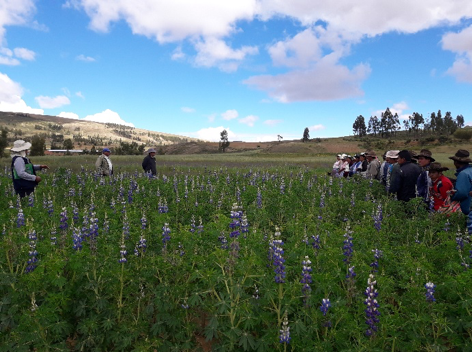
Context and objectives:
The High Andes of Bolivia and Ecuador and the Araucania in Southern Chile are highly vulnerable to climate change. Farmers have very limited options to improve their production systems. Lupinus species offer an alternative due to their resilience to adverse weather and soil conditions. In Bolivia and Ecuador about 1500 ha and 5997 ha of bitter Lupinus are cultivated, respectively. While in Chile during the last five years, bitter Lupinus which is exported for human consumption, has been cultivated in areas that fluctuate between 4600 and 12300 ha. Sweet Lupinus which is used for animal feed has been cultivated in areas that fluctuate between 5900 y 12700 ha. Bitter Lupinus are highly nutritious, but they also contain alkaloids which need to be removed for human consumption, through a highly laborious process which demand high water use.
The main Project objective it to promote the development of technological innovations to strengthen the resilience of production systems through the introduction of Lupinus and contribute to improve farmers’ wellbeing.

Proposed Solution:
The Project had the following components: 1) Increasing the productivity of production systems, 2) Promoting the use and local consumption of Lupinus as a balanced food, 3) Development of postharvest technologies and increasing access to new local and national markets 4) Manage the Project through an innovation platform.
Main results:
In Bolivia,
- High yield variability was found between species in dry (270 mm) and normal years (450 mm)
- The Apion sp beetle and Anthracnose (Colletotrichum spp) can reduce yields by up to 80% and 40%, respectively
- A threshing machine was introduced to reduce labor and optimize grain production
- A technology to remove alkaloids was validated. It reduced wáter use from 80 to 40 l/kg of grain
- A cooking book containing nine dishes of Lupinus based on local knowledge was prepared and distributed to other families.
- A partnership was established with a local enterprise to develop a new image for lupine as well as three processed products, which are now being sold in the two main supermarket chains in Cochabamba. In 2017, 1500 units were sold per month.
In Ecuador,
- Fertilization with NPK (27,69,0) increased yields significantly (from 515 to 909 kg/ha).
- Local varieties showed good yields, however due to their tardiness they could not compete in drier years with the new variety “INIAP 450 Andino”.
- A new technique to remove alkaloids was tested. It diminished processing time from 84 to 58 hours and water consumption from 96 to 66 l/kg of grain.
- Unmarked and fresh lupine is consumed by 71 % of families in the highlands, 20 % in the Coast and 87 % in the Eastern lowlands. Per capita consumption per year is 4 kg in the highlands and Eastern lowlands, and 2 kg in the Coast.
- Partnerships were developed with private enterprises to evaluate acceptability and preference of various lupine products (flour, crunchy grains, liophilized, frozen, canned, flavored milk, youghurt).
- In 2017, the first export (300 kg) of lupine flour was done to the Czech Republic.
In Chile,
- albus showed higher yielding potential than the other two species. The “Alboroto INIA” variety showed an average yield of 4,7 t/ha in the first season and 5,7 t/ha in the second one. L. angustifolius showed and intermidiate yield and L. luteus showed the lowest one.
- luteus had the highest protein percentage, followed by L. albus and L. angustifolius. However, L. albus is the most efficient producer of protein per ha, yielding over 1500 to 2000 kg/ha.
- BYMV (Bean Yellow Mosaic Virus) is a potential problema for lupine production in Southern Chile. A rye hedge surrounding lupine parcels contained the invasion of aphids and reduced significantly the incidence of BYMV.
- A meeting was organized with a feed mil company which caters to the salmon industry. As a result, the company decided to get involved in the purchasing and processing of lupine.




